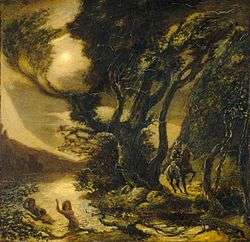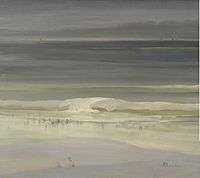Tonalism

Tonalism was an artistic style that emerged in the 1880s when American artists began to paint landscape forms with an overall tone of colored atmosphere or mist. Between 1880 and 1915, dark, neutral hues such as gray, brown or blue, often dominated compositions by artists associated with the style. During the late 1890s, American art critics began to use the term "tonal" to describe these works. Two of the leading associated painters were George Inness and James McNeill Whistler.
Australian Tonalism emerged as an art movement in Melbourne during the 1910s.
Tonalism is sometimes used to describe American landscapes derived from the French Barbizon style,[1] which emphasized mood and shadow. Tonalism was eventually eclipsed by Impressionism and European modernism.
Associated artists
Gallery
-

Albert Pinkham Ryder, Siegfried and the Rhine Maidens (1888 - 1891), National Gallery of Art, Washington, DC
-

George Inness, Summer Landscape, 1894
-

John H. Twachtman, The White Bridge, ca. 1895, Minneapolis Institute of Arts
-

Leon Dabo, The Seashore, ca. 1900; Oil on masonite; 76.8 x 86.4 cm
Notes
- ↑ Avery, Kevin J. & Fischer, Diane P. "American Tonalism: Selections from the Metropolitan Museum of Art and the Montclair Art Museum ". Burlington Magazine, Vol. 142, No. 1168, July, 2000. p. 453.
External links
- American Paintings in The Metropolitan Museum of Art, a fully digitized 3 volume exhibition catalog
- American Tonalism - Montclair Art Museum
- askart.com
- Leon Dabo